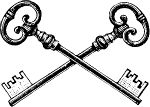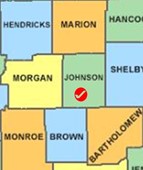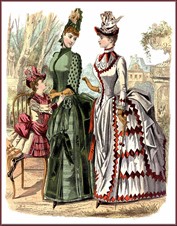Archive for the ‘Sherman’ Category
Mary C. Scott of Edgar County
 We have a road trip coming up this summer, and I plan to visit some courthouses and repositories along the way. I am looking forward to a stop in Edgar County, Illinois to learn more about the life of my second great-grandfather, Thomas Sherman (1841-1912), who lived there in the 1870’s.
We have a road trip coming up this summer, and I plan to visit some courthouses and repositories along the way. I am looking forward to a stop in Edgar County, Illinois to learn more about the life of my second great-grandfather, Thomas Sherman (1841-1912), who lived there in the 1870’s.
According to census records, Thomas was married three times. I descend from the first wife. She disappeared from the scene shortly after my great-grandmother Anna Sherman was born in 1865. Anna then lived with her paternal grandmother Rebecca Sherman until Thomas remarried in 1872.
This marriage to this second wife will be the focus of my courthouse visit in Edgar County. She had disappeared from our family lore. From previous research, I knew a bit about about her:
- Her name was Mary. She was listed as the wife of Thomas Sherman on the 1880 census for Edgar County.
- Thomas Sherman and Mary Scott were married in the Methodist Church in Edgar County in 1872. His residence was Logan P. O., Brouiletts Creek Township.
- Mary Scott Sherman was my great-grandmother’s stepmother during Anna’s coming of age. Anna became a devout Methodist, influenced perhaps by the woman who raised her.
- Mary had disappeared from Thomas’ life by September 1881 when he married his third wife, Alice Farris (1862-1931).
Thomas and Mary’s 12-year marriage produced no children. What had happened to her?
Hoping to find more about her and her family, I resumed the search last week in the Edgar County records that are found online:
- Because she had married Thomas in Edgar County in 1872, I hoped she had resided there in 1870. If she did, I should be able to find her there on the 1870 U. S. census. I located five women with that name in the county that year. Three of them I could eliminate because they were already married in both 1870 and 1880. That left Mary Scott of Elbridge who was married to John Scott by 1870 but was not listed in the county in 1880, and Mary C. Scott (b. abt. 1849) of Logan P. O. Brouiletts Creek Township who lived with her parents Harriet and Matthew R. Scott. The last Mary was a single woman residing in the same community with Thomas Sherman, and I hypothesized she was his bride in 1872.
- In 1873, a year after the marriage, Matthew R. Scott conveyed 10 acres of land in Edgar County to Mary Sherman. It seems likely that he granted this land to his daughter Mary who was now Mary Sherman.
- On 15 February 1894, Mary Caroline Scott (b. abt 1849) married Franklin Nathaniel Horsley in Edgar County. It was her second marriage.
- In 1900, Mary Horsley of Edgar County was living apart from her husband.
- By 1910 and 1920, Mary Scott was single and had resumed using her maiden name.
- Mary Caroline Scott (1849-1921) passed away in Bruiletts Township, Edgar County. She was buried in the Scott family cemetery.
This evidence seems to indicate that Mary Caroline Scott, daughter of Matthew R. Scott, married first Thomas Sherman and second Franklin Horsley. Did both marriages end in divorce?
I will stop in the Edgar County courthouse in hopes of finding out. Divorce records for the county are not online. The Handybook for Genealogists says that the County Clerk has divorce records, but it does not specify years. A courthouse visit will allow me to search for Mary Caroline Scott’s divorce records, if any, and any other court cases involving her.
A Family of Black Sheep
 Families come in all shapes and sizes. Often they have individual members who contribute to society in ways that benefit everyone. Mine, not so much. One could describe many of our relatives as black sheep ancestors, or those who behaved in disreputable or disgraceful ways.
Families come in all shapes and sizes. Often they have individual members who contribute to society in ways that benefit everyone. Mine, not so much. One could describe many of our relatives as black sheep ancestors, or those who behaved in disreputable or disgraceful ways.
When I found a new branch of my dad’s family this year, I should not have been surprised to find that it, too, is peopled with black sheep. Every one of my dad’s grandparents had skeletons in the closet:
- Reed. My great-grandfather left his family and squandered his inheritance on fruitless land speculation. A Reed cousin defected to East Germany during the Cold War.
- Riddle. A distant great-uncle sued his brother over the family farm, leaving his sibling destitute and without means to make a living. Another brother served time for larceny and then became a reclusive sheepherder in Montana.
- Ryan. Over three generations, these men abandoned their children, either leaving them to be raised by relatives or placing them in orphanages. Some cousins were Nebraska bootleggers during Prohibition.
- Sherman. These blacksmiths believed in homemade money. Several were arrested for counterfeiting. One was shot and killed in his bed by a disgruntled associate.
As I uncover more of this doubtful legacy, I begin to wonder about the advice our great-grandfather Reed left with his offspring. He told them, “You inherited a good name, now keep it that way.”
Oh, the irony.
A Promising DNA Match
 You always hope that DNA testing will help you make a breakthrough on one of your blocked ancestral lines. After all, that is one of the reasons for taking the test. This week, I got lucky.
You always hope that DNA testing will help you make a breakthrough on one of your blocked ancestral lines. After all, that is one of the reasons for taking the test. This week, I got lucky.
My dad and I took the tests with a couple of companies a few years ago because we have some unidentified ancestors in recent generations. Traditional research has gotten me nowhere in identifying these ancestors:
- The parents of my great-great grandfather John Davis Riddle (1821-1896)
- The mother of my great-grandmother Anna Petronellia Sherman (1865-1961), reported in family papers to be a German immigrant to Indiana named Katherine Stillenbaugh/Stanabaugh.
- The father of my grandmother Grace Riddle (1896-1976).
Over many months I have periodically reviewed our DNA matches searching for a clue on one of these lines. Most of our matches were quite distant, 4th cousins or so. For those whose names I recognized, the Most Recent Common Ancestor was someone I already had in my family tree, and the matching information did not provide any help other than to confirm that we are genetically related. For those matches whose names I did not recognize, identifying common ancestors proved very difficult, and often I have not yet been able to discern the relationship.
Then there were the close matches—2nd cousins to my dad. Both were adoptees searching for their birth parents. One lives in Montana and the other in Nebraska. We had forebears in both states, but I am sorry to say I was unable to determine how we are related to these two people. I could offer them no help.
Despite the lack of real progress from DNA testing, I keep trying to learn more about the process. Yesterday, I listened in on a Legacy webinar by Blaine Bettinger, author of The Family Tree Guide to DNA Testing and Genetic Genealogy. He reminded listeners that the testing companies have the option to post family trees. He advised looking over those posted by your close matches. I had some time and decided to do that again.
Some of my matches had no trees posted. Others were not available for public viewing.
Then I came to one for a man identified as a 2nd-4th cousin to my dad. His tree lists a great-grandmother named Lula Stilabower.
I have long suspected that my ancestor Katherine Stillenbaugh/Stanabaugh was actually a Stillabower/Stilgenbauer. This large German immigrant family (including Lula) lived in the same area south of Indianapolis where my great-grandmother Anna was born to the mysterious Katherine. Now I have a DNA match to someone from that family.
Of course this is not conclusive proof that my DNA match and I are related through this line. To do that, I need to find another person who descends from the Stillabower/Stilgenbauer line and who matches both of us. Even with DNA proof, I still will not know how my Katherine fits into the Stilgenbauer family.
But this clue is a pretty good start. As more and more people test their DNA I might just get that third person who will enable me to triangulate this result. I would love to verify my descent from the Stilgenbauers and learn more about that teensy bit of German heritage (1/16) that I have.
This Week’s Genealogy Happenings
 Sometimes I cannot spend a week focused on just one genealogy activity. Too much goes on around me.
Sometimes I cannot spend a week focused on just one genealogy activity. Too much goes on around me.
- A new distant cousin recently contacted me. She has taken a DNA test with Ancestry. I have not tested with that company, but one of my second cousins has. They were a match. The new cousin asked the second cousin for information on our common Sherman line. Not having much about it to offer, my second cousin referred the new cousin to me. I learned that the new cousin is descended from my Thomas Sherman’s (1841-1912) younger brother, John. Our common brick wall ancestor is the father, Daniel Sherman (abt. 1800-?). I am very excited to have a collaborator for this Sherman research, and I hope we can make some progress together on the Sherman line.
- Information from the new cousin equipped me to fill in the descendance of John Sherman. He had been the most difficult of the Sherman brothers for me to trace because he moved around a lot and had such a common name. The new cousin sent me his 1943 obituary, and that opened the door to locating information on his children and grandchildren. I have barely begun the process of putting it all into my database.
- Genealogists need and enjoy some social time. Once a month, members of the Colorado Genealogical Society (CGS) meet for lunch. Yesterday we gathered at a new American Indian restaurant. As we ate delicious Indian tacos and shredded bison, we swapped research tales and talked about upcoming training opportunities.
- I continue to take time to read the periodicals put out by CGS and the National Genealogical Society (NGS). I often get research ideas from these publications. The most recent NGS magazine has a good article by Michael Lacopo on how to find religious newspapers and use them for research on 19th and 20th century ancestors. I hope to follow through with some of his suggestions to find information on the Shermans and others.
As this week ends and a new one begins, I plan to get back on task. I continue to work on contacting DNA matches at FamilyTreeDNA and 23andMe. Wouldn’t it be great if I could find a male Sherman match who would take a Y DNA test? That would move us ahead in finding the origins of Daniel Sherman.
A Key Sparks a Conversation
 A few days ago, my young granddaughters made a discovery when they visited my house. They found my blacksmith’s iron key. They wanted to know what it was and why I had it.
A few days ago, my young granddaughters made a discovery when they visited my house. They found my blacksmith’s iron key. They wanted to know what it was and why I had it.
Their curiosity presented me with a teachable moment and an opportunity to tell them a little about their family history. I explained that they come from a long line of blacksmiths in the Sherman branch of their family tree. My key reminds me of that although it does not unlock anything that I own. It serves as a paperweight.
I have not had it very long. Knowing my family history, my husband/tech advisor gave me the key and several richly-illustrated children’s books about blacksmiths for Christmas last year. Now I was happy to share some information about blacksmithing with the girls.
I explained that the key they found is a replica of antique keys once made by blacksmiths. They were amazed that common household items like farm tools, pots, locks, and keys used to be made, one at a time, by village blacksmiths, including their ancestors. As we discussed the role of a blacksmith in the community, they were relieved that today they have the luxury of visiting a dentist instead of needing the blacksmith to pull a bad tooth with the same tool he used to remove nails from a horse’s hoof.
The girls liked the photos of blacksmiths hammering hot metal at the anvil while wearing heat-resistant leather aprons. They learned new words like forge and smithy and bellows. One of girls recalled visiting a working blacksmith shop at the Littleton [CO] Historical Museum. Now the other granddaughter wants to see it, too.
Not bad for a spur-of-the-moment history lesson.
A New Insight For a Brick Wall Ancestor
 My third great-grandfather, Daniel Sherman, seemingly dropped out of the sky into Kentucky in the 1820’s. I know nothing about his life before then. His place and date of birth, family members, and reason for settling in Kentucky all elude me.
My third great-grandfather, Daniel Sherman, seemingly dropped out of the sky into Kentucky in the 1820’s. I know nothing about his life before then. His place and date of birth, family members, and reason for settling in Kentucky all elude me.
He showed up in Morgan County, KY in the mid-1820’s. There he married Rebecca Howe Day on 4 September 1826. After that, his name appears regularly in the Kentucky records until 1863. That April, he and Rebecca sold a small plot of land, and Daniel disappeared from the record as mysteriously as he entered it.
U. S. census records for 1850 and 1860 tell me that Daniel was a blacksmith born around 1800 in either New York or Vermont. Why a guy from that region would relocate to Kentucky always puzzled me. Migration from the far north to the south does not match the usual migration patterns I have seen.
The other day, I mentioned this question to a fellow genealogist who has New York ancestors herself. She came up with a possible explanation. She reminded me that Kentucky is horse racing country, and that industry needs blacksmiths. Could that be why Daniel Sherman went to Kentucky?
My friend got quite interested in this line of inquiry and followed up by contacting the historical society in the last county where my ancestor lived—Madison County, KY. The President of the Society, Tom Black, replied with the following information:
All of Kentucky had lots of horses through the 19th century. Locally, most of them were work horses which also needed a blacksmith’s attention so he could have potentially been servicing them. We had no race horses of note that I am aware of and no local farms that had more than a handful. However, show horses have been a Madison County staple for a long time, and we have seen a great number that were competitive and a few that became champions. All that said, he would have been a busy man if working locally.
Perhaps Daniel followed an opportunity when he headed south. If he became a busy man working as a Kentucky blacksmith, he was fortunate to have four sons. They all learned the blacksmith trade and became working blacksmiths themselves. Some of Daniel’s grandsons followed that profession, too, until it faded away after World War I. Horse country provided them all with a means to make a living.
Historic Newspapers Come Up Short
 My ancestors Thomas Sherman and Katherine Whoever-She-Is lived south of Indianapolis around the time of the Civil War. At least I think they did. He registered for the Civil War draft at Nineveh, Johnson County, Indiana in 1863, but that is the only mention of him in that location. I would like to find more.
My ancestors Thomas Sherman and Katherine Whoever-She-Is lived south of Indianapolis around the time of the Civil War. At least I think they did. He registered for the Civil War draft at Nineveh, Johnson County, Indiana in 1863, but that is the only mention of him in that location. I would like to find more.
This week I combed all the Indiana historic newspaper databases I could find searching for Thomas’ name:
- Newspapers.com (https://www.newspapers.com/) has nothing for the 1860’s Nineveh area.
- Hoosier State Chronicles (https://newspapers.library.in.gov/) has several newspapers from Johnson and nearby Bartholomew County, but few issues from the 1860’s survive. I found no mention of Thomas or any of his family.
- Library of Congress Chronicling America (http://chroniclingamerica.loc.gov/) has no newspapers from the Nineveh area during the 1860’s.
Thomas and Katherine seem to have been very obscure people who resided in a sparsely-populated area. He lived in Indiana between census years, and I have not found a likely candidate for her on the 1860 census. His name did not appear on the Johnson County land ownership plat for 1866-7. I have spent another week searching for them only to turn up nothing.
Not to be discouraged, I still have more to do before I can claim to have made an exhaustive search for these people. Slowly I am working my way through my research checklist. I still need to search church records and tax lists. These records present more of a challenge to locate, so I looked in other places first. Surely my ancestors left behind more than a Civil War draft registration.
A Plat as a Census Substitute
 My mysterious German ancestor lived in Indiana during the Civil War. I believe she had already immigrated to the U. S. by 1860, but I have not located her on the 1860 census. By the time of the 1870 census, she had died. In between these years, she purportedly married my great-great grandfather and bore a daughter.
My mysterious German ancestor lived in Indiana during the Civil War. I believe she had already immigrated to the U. S. by 1860, but I have not located her on the 1860 census. By the time of the 1870 census, she had died. In between these years, she purportedly married my great-great grandfather and bore a daughter.
Verifying this information presents a real challenge. How I wish Indiana had taken a state census in 1865. This couple’s daughter, my great-grandmother Anna Petronellia Sherman, was born in April that year. This little family would have been listed on a state census. Research on my German ancestor would have taken a step ahead.
But Indiana did not take a census that year, and I have found very few records from that decade. This week I looked at one of them, an 1866 plat of Johnson County, Indiana. The Sherman family lived there for a time. The map serves as a substitute of sorts for the absence of a mid-decade census.
I ordered this map from the Family History Library in Salt Lake, and it came on two microfiche. The map had separate sections for each incorporated area in the county as well as a broader map showing all the landowners in the rural areas. The writing was faint, and it appeared in different orientations throughout the maps. This made it hard to view on a microfiche reader.
I spent upwards of two hours looking at this plat to see if I could locate any familiar names:
- Anna Petronellia Sherman, was born at Edinburg in 1865. The plat showed the layout of this town and identified local businesses, but it did not place names on individual residences. I found no clue of where, or if, any Shermans still lived there in 1866.
- My great-great grandfather, Thomas Sherman, and his older brother Anderson registered for the Civil War draft at Nineveh in 1863. The plat for Nineveh did label individual residences, but again I found no mention of a Sherman family in 1866.
- My great-great grandmother is identified in family records as Katherine Stillenbaugh/Stanabaugh. I continue to work under the hypothesis that she was part of the extended Stilgenbauer/Stillabower clan of German immigrants who lived south of Indianapolis. There was a “Stigenbauer” residence next door to the Post Office in Nineveh in 1866. This puts the Shermans and the German family in the same county at about the same time.
- I found no mention of any Sherman or Stilgenbauer landowners on the farms in the county. For the Shermans this was not a surprise. They were blacksmiths and owned little, if any, farmland over the years.
After examining these plats, I have little new information. I do have a better understanding of the neighborhoods my ancestors frequented. I took down the names of all the householders in Nineveh because some of these people would have been acquaintances of my family members. Their records may mention my own family.
My local family history center received the Johnson County plat microfiche on extended loan, so I can view them again if I uncover other information about my families. I still wish Indiana had taken a census listing all heads of household in the mid-1860’s, but these plats provide something of a census substitute.
Centenarians in the Family
 We have some longevity in our family. My own father will reach the age of ninety this year, and several of his cousins lived into their nineties, too. One claimed she would be the first Reed to live to the age of 100, but she did not make it. Maybe my father will claim that accomplishment.
We have some longevity in our family. My own father will reach the age of ninety this year, and several of his cousins lived into their nineties, too. One claimed she would be the first Reed to live to the age of 100, but she did not make it. Maybe my father will claim that accomplishment.
Some of his more distant relatives have lived even longer than that. I know of two well-documented cases of women in our family who passed the century mark:
- Maggie Sherman Hendricks (1872-1976). Maggie was my dad’s first cousin, twice removed, on his father’s side. The daughter of Anderson Sherman and Sarah Jane Prewitt, she was born in Indiana. She died at age 104 and is buried in the Greenlawn Cemetery in Franklin, Indiana. The family story says that Anderson Sherman’s maternal grandmother, who was my dad’s third great-grandmother, lived to be 111 years old. Perhaps Maggie (and my dad!) received some good genes from her.
- Lula Mae Riddle Ferris (1893-1999). Lula Mae was a Michigan farm wife and my dad’s first cousin, once removed, on his mother’s side. Her parents were Ethan Henry Riddle and Sophronia McClish. The maternal line for both Ethan Riddle and my dad comes from New England stock which is known for longevity. When Ethan’s daughter Lula Mae passed away at the age of 105, she had come close to living in three different centuries. She is buried in Leonidas Cemetery in St. Joseph County, Michigan.
I wonder whether these people were glad to live that long. My dad does not seem to get much enjoyment out of life any more, and he is still many years younger than these cousins lived to be. With the infirmities of extreme old age, one must give up many of the things one once enjoyed. That is why the adage says we all want to live longer, but we do not want to grow old. I would agree with that.
Katherine, Still MIA
 Despite several hours’ work, I have made no real progress in my search for my elusive German ancestor, Katherine Stillenbaugh/Staninbaugh. I have been unable to find any evidence supporting the hypothesis that she belonged to the Stilgenbauer/Stillabower clan that lived south of Indianapolis, IN in the 1860’s:
Despite several hours’ work, I have made no real progress in my search for my elusive German ancestor, Katherine Stillenbaugh/Staninbaugh. I have been unable to find any evidence supporting the hypothesis that she belonged to the Stilgenbauer/Stillabower clan that lived south of Indianapolis, IN in the 1860’s:
- Using census records and county histories, I constructed family trees for the three immigrant patriarchs who lived in that area: Jacob (1796-1865), Adam (1801-1863), and Johan Michael (1804-1881). Although I found several daughters and granddaughters, some named Catherine, none of these girls seem to fit the profile of my ancestor. Either they were born in the U.S. instead of Germany, died in childhood, or married someone other than my Thomas Sherman.
- I combed through the online databases for the Allen County Public Library, the Indiana Historical Society, the Indiana State Archives, and the Indiana State Library. I found almost no mention of either the Sherman family or the Stilgenbauer/Stillabower family.
- I reviewed the Family Search catalog for Johnson County, Indiana (where the Shermans lived and Katherine’s daughter was born in 1865) to determine whether they hold any records I might find helpful. The Johnson County courthouse burned in 1874, so many records were lost. They do not have much that I have not already analyzed.
Where do I go from here? I have a few steps in mind:
- Family Search does have a microfiche copy of an 1866 land ownership map for Johnson County. I could order that to help re-create the Sherman’s neighborhood at that time. People came and went between census years, and the map might hold additional names to search.
- One of Thomas Sherman’s sisters married Stephen Dyke, and this family remained in Johnson County after most of the other Shermans had moved on to Illinois and Missouri. I have done little research on the Dykes. Perhaps the records of these relatives hold a clue to my Thomas and his first wife.
- The Stilgenbauer/Stillabower families lived primarily in Brown and Bartholomew Counties, both adjacent to Johnson County. I can do more research in the records of those counties.
- I have not yet looked at land and probate records. I have not found an online source, and perhaps these records were destroyed in courthouse fires. I need to investigate this research avenue.
- DNA testing could provide a connection to the Stilgebauer/Stillabower line. I need to review our matches for this possibility.
In the meantime, Katherine remains a brick wall ancestor.